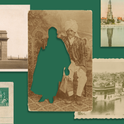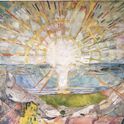A Venetian fruit market
The best thing about Venice is that there is no need to write anything about it because everything has already been written before. Even the idea that there is nothing new to write about Venice is not new; I think I may have come to it third hand. For a writer I found this to be curiously relaxing. No need to describe the mazy wonder of sage-green canals or bridges that trip in triplicate circles, no need to recount the 2,000 years of unbroken history from Rome via Byzantium to the Renaissance. Venice is beautiful and famous; I don’t have to pretend to discover it.
Instead I walk and walk and walk. Every glance and glimpse, every shutter blink is more gracefully deliquescent than the last. A sliding gondola, a gargoyle with one eye, a little shop with an old man marbling paper with floating oily inks, a bobbing market boat overflowing with five kinds of artichoke, immigrant vendors selling selfie sticks on the Rialto Bridge. My mind was lulled by my own metronomic footsteps; touristy palazzo, quiet backwater... ah, I am lost again!
I walked five, six hours a day. I walked and I ate. When I was tired I took advantage of the traditional respite of the Venetian bàcari, wine bars that sell cicchetti, snacks that often take the form of two-bite toasts with something delicious on top. My favourite was Cantinone già Schiavi, run by three brothers and their indomitable mother, a champion cicchetti maker with certificates on the wall to prove it. I would point to two or three: smoked herring, pumpkin and ricotta, salmon and mascarpone, egg with mushrooms and truffle, shrimp and artichoke, brie topped with nettle purée. And whatever the time of day I ordered a prosecco. Prosecco is Venetian Coca-Cola. It’s thirsty work, all that walking.
“You don’t plan to eat cicchetti,” my friend Fabrizio Paone, an elegant professor of architecture, told me. “It just happens.” In Venice everyone walks everywhere. Along the canals, over the bridges, down the narrow alleys, carrying your shopping, it begins to rain, it is lunchtime, it is mid afternoon, you bump into a friend; inevitably you need a place to stop and have a little something to drink, a little something to eat. Fabrizio comes from Genoa, Venice’s old arch-rival, and he had observed that “there is a preference among the Venetians for soft food. Look at artichokes—they eat only the bottoms and they throw away the leaves. Once I went to dinner with a friend who was—we can say—a Venetian patrician, and the best thing on the menu was a steak but he didn’t order it because it was served on the bone and he complained ‘it’s too hard, it’s too much trouble.’” Venice was an independent republic until Napoleon arrived. “Venice is unique,” he said. “There is a strong idea that food should not be refined, cicchetti should not be elaborate.”
Once he had said this I began to notice this softness throughout Venetian cuisine. From the mild briny spaghetti alle vongole to rich cuttlefish stewed in its own black ink and tomatoes, nutty wholewheat bigoli with molten onions and anchovy and pearly squid roe that had the texture of solid milk.
Like everything I encountered or experienced in Venice, I found the Cantina Do Spade by accident. I was wandering through the Rialto market one morning and got lost in a warren of alleys. In the shadow of a brick tunnel I saw an old man sitting on a bench with a harmonica in his lap and next to him one of those unaccountably enticing unprepossessing doorways with a handwritten sign tacked up: risotto di giorno 6 euros.
Inside the walls were painted slate blue. A glass of prosecco. A plate of sarda in saor, sardines preserved in soft-cooked onions with raisins and pine nuts, a small dish of seafood risotto, perfectly all‘onda, wave-like, loose and oozy.
I asked Do Spade’s proprietor, Francesco Munarini, about Fabrizio’s theory of Venetians preferring “soft food” and he nodded, yes, it was true, there was a tradition of conserving food, of long cooking times, even overcooking. He told me the story of how the most ubiquitous Venetian dish, baccalà mantecato, came to be. Following the Council of Trent decree in the mid-16th century that meat must be avoided during Lent, the Venetians suddenly needed a way to satisfy the demand for fish. Cod was dried and salted to preserve it, and later made edible by beating it with olive and garlic into a creamy paste. Wherever you stop for cicchetti you are bound to find baccalà mantecato spooned onto little rounds of bread. If you sit down in a restaurant it will be served with polenta—equally unctuous and soft.
Instead I walk and walk and walk. Every glance and glimpse, every shutter blink is more gracefully deliquescent than the last. A sliding gondola, a gargoyle with one eye, a little shop with an old man marbling paper with floating oily inks, a bobbing market boat overflowing with five kinds of artichoke, immigrant vendors selling selfie sticks on the Rialto Bridge. My mind was lulled by my own metronomic footsteps; touristy palazzo, quiet backwater... ah, I am lost again!
I walked five, six hours a day. I walked and I ate. When I was tired I took advantage of the traditional respite of the Venetian bàcari, wine bars that sell cicchetti, snacks that often take the form of two-bite toasts with something delicious on top. My favourite was Cantinone già Schiavi, run by three brothers and their indomitable mother, a champion cicchetti maker with certificates on the wall to prove it. I would point to two or three: smoked herring, pumpkin and ricotta, salmon and mascarpone, egg with mushrooms and truffle, shrimp and artichoke, brie topped with nettle purée. And whatever the time of day I ordered a prosecco. Prosecco is Venetian Coca-Cola. It’s thirsty work, all that walking.
“You don’t plan to eat cicchetti,” my friend Fabrizio Paone, an elegant professor of architecture, told me. “It just happens.” In Venice everyone walks everywhere. Along the canals, over the bridges, down the narrow alleys, carrying your shopping, it begins to rain, it is lunchtime, it is mid afternoon, you bump into a friend; inevitably you need a place to stop and have a little something to drink, a little something to eat. Fabrizio comes from Genoa, Venice’s old arch-rival, and he had observed that “there is a preference among the Venetians for soft food. Look at artichokes—they eat only the bottoms and they throw away the leaves. Once I went to dinner with a friend who was—we can say—a Venetian patrician, and the best thing on the menu was a steak but he didn’t order it because it was served on the bone and he complained ‘it’s too hard, it’s too much trouble.’” Venice was an independent republic until Napoleon arrived. “Venice is unique,” he said. “There is a strong idea that food should not be refined, cicchetti should not be elaborate.”
Once he had said this I began to notice this softness throughout Venetian cuisine. From the mild briny spaghetti alle vongole to rich cuttlefish stewed in its own black ink and tomatoes, nutty wholewheat bigoli with molten onions and anchovy and pearly squid roe that had the texture of solid milk.
Like everything I encountered or experienced in Venice, I found the Cantina Do Spade by accident. I was wandering through the Rialto market one morning and got lost in a warren of alleys. In the shadow of a brick tunnel I saw an old man sitting on a bench with a harmonica in his lap and next to him one of those unaccountably enticing unprepossessing doorways with a handwritten sign tacked up: risotto di giorno 6 euros.
Inside the walls were painted slate blue. A glass of prosecco. A plate of sarda in saor, sardines preserved in soft-cooked onions with raisins and pine nuts, a small dish of seafood risotto, perfectly all‘onda, wave-like, loose and oozy.
I asked Do Spade’s proprietor, Francesco Munarini, about Fabrizio’s theory of Venetians preferring “soft food” and he nodded, yes, it was true, there was a tradition of conserving food, of long cooking times, even overcooking. He told me the story of how the most ubiquitous Venetian dish, baccalà mantecato, came to be. Following the Council of Trent decree in the mid-16th century that meat must be avoided during Lent, the Venetians suddenly needed a way to satisfy the demand for fish. Cod was dried and salted to preserve it, and later made edible by beating it with olive and garlic into a creamy paste. Wherever you stop for cicchetti you are bound to find baccalà mantecato spooned onto little rounds of bread. If you sit down in a restaurant it will be served with polenta—equally unctuous and soft.













